You are using an out of date browser. It may not display this or other websites correctly.
You should upgrade or use an alternative browser.
You should upgrade or use an alternative browser.
kesobie
100+ Head-Fier
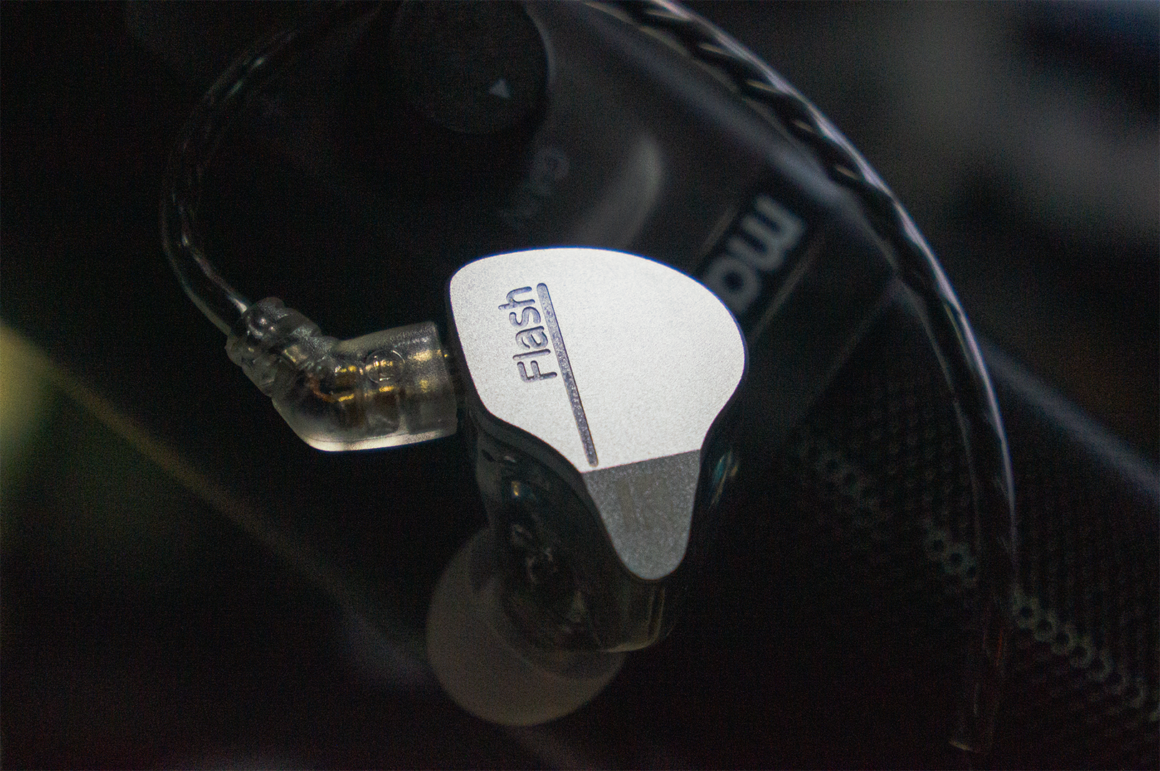
WATCH FULL REVIEW HERE:
PRICE: $25
PROS:
- Comfortable, lightweight fit
- Smooth, laid back and musical sound
- Analogue-like vocal and instrument presentation
- Fatigue-free treble
- Good coherency and timbre
CONS:
- Cheap build quality
- Needs tip-rolling
- Subpar technicalities
- Shout tendency
- Rolled-off treble might sound too dark
WHO THIS UNIT IS FOR:
- People who like a laid back, musical IEM
- People who like an analogue-like sound
- People who like forward upper mids
- Treble sensitives
WHO THIS UNIT ISN’T FOR:
- People looking for a technical focused set
- People who want a premium build
- People who want a neutral tuned set
- Trebleheads
RECOMMENDED GENRES:
- Hip-hop
- Disco
- Rock
SHORT REVIEW:
KBEar shows a Flash of hope with its warm, laid-back tuning that is surprisingly coherent and analogue-like in sound. Its focus on musicality makes it a very solid chill set for long listening sessions. It however fails to be competitive with the ever-evolving market due to its subpar technical ability and cheap build, but it’s at least a step in the right direction. RECOMMENDED WITH CAVEATS
KBEar has undoubtedly been on the low as of recent. Whether you like it or not, one of the pioneers of Chi-fi have fallen from grace with many of their recent releases. However, they still stand strong and attempt different tuning styles and concepts and seeing which sticks. So, how does their last release in 2023 write their story for 2024?
DISCLAIMER: KBEar Flash was sent to me in exchange for my honest impressions. I am eternally grateful for the opportunity. I was not paid. Rest assured, my thoughts and opinions on this product will be of my own honest opinions and will not be affected by the fact beforehand.
Audio is a very subjective hobby and as much as I try to objectively explain my thoughts and opinions, your mileage will vary. My preferences will also affect how I perceive the gear that I review. Sources and other accessories will also modify your experience. Lastly, my reviews should always be used only as a guide and not as the definitive bible. Trust your ears to know what’s good.
SOURCES USED:
- HiBy Digital M300
- HiBy R6 III
- Zishan U1
- Non-HiFi Smartphone
- VE Avani
TRACKS USED:
A mixture of lossy, lossless and Hi-Res files will be used to give a general overview of the different formats in which the gear will be used.
Docs file explaining each track and what to look for: https://docs.google.com/document/d/1oMa7GPLaqtpnnoR9tixvWI4aK-7tXMyTEZCJAVkIZx0/edit
Spotify Playlist:
PREFERENCES:
I currently prefer a lot of R&B, Indie, Funk and Adult Contemporary. However, I am very flexible with the music that I listen to and always try to look for the best genres for the gear. I am also a self proclaimed treble head but loves warmer lower mids
ACCESSORIES USED:
Tips:
- Stock Tips
- KBEar07
- TRI Clarion
- Tangzu Sancai
Cable:
- Stock Cable
SPECIFICATION SHEET
Driver Size and Setup: 1DD + 1BA
Impedance: 32ohms
Sensitivity: 108db
Frequency Range: 20hz - 20khz
Build: Aluminum Alloy + PC
Cable Length: 120cm/200cm
Cable Material: 4N OFC Silver Plated
Termination: 3.5mm
Interface: 0.75 QDC
KBEar Flash is KBEar’s latest and last release for 2023. Calling back to their hybrid days, this $24 in-ear monitor seems to be a return to form for KBEar which I will be taking a very in depth look in this review.
UNBOXING EXPERIENCE:
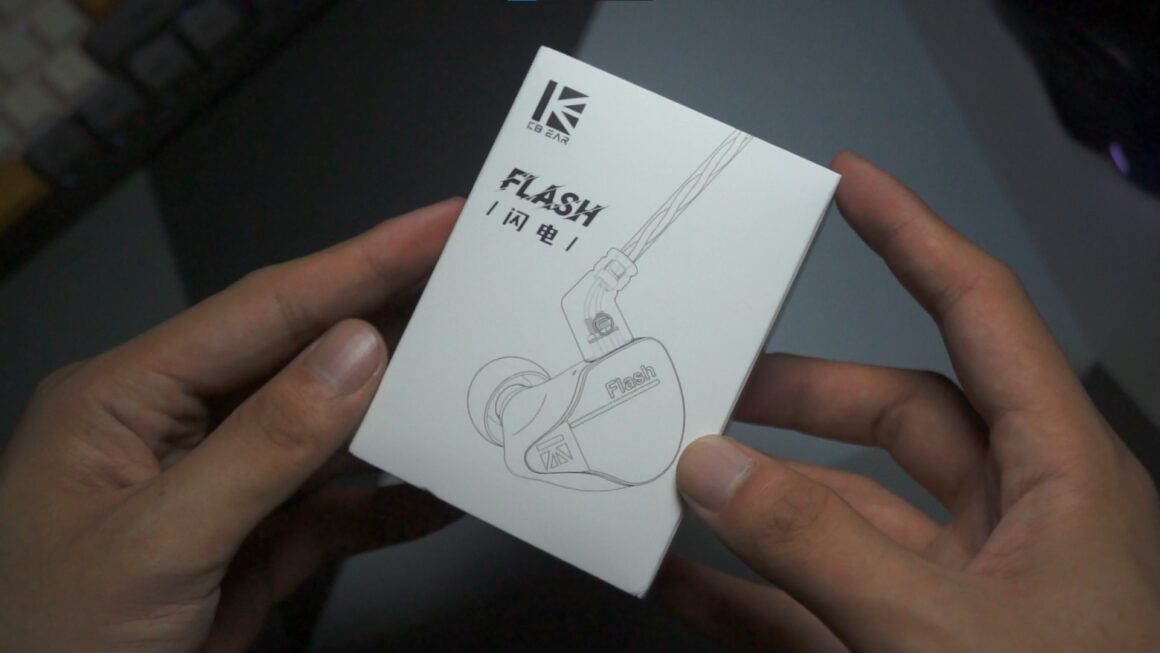
The Flash’s box is KBEar’s usual medium sized box with line-art of the in ears up front and the usual specifications on the back
Opening the box shows the familiar presentation of a plastic cover protecting the IEMs sitting in a paper-foam cutout with the cable, tips and paperwork found under the box.
Here’s a full list of the accessories:
- 1 pair of KBEar Flash in-ears
- 6 pairs of eartips
- 1 0.75 QDC 1.2m 3.5mm cable
- Warranty and Manual paperwork
I will admit, I’ve been quite spoiled with the likes of the Tangzu Wan’er providing quite decent eartips with their package which made my tip rolling experience with the Flash quite disappointing. It’s your usual duo of narrow and wide bore eartips made with a rather cheap material that is both thin and stiff which causes discomfort and seal issues to my ears. The narrow bored eartips fair better, but still irritates my ears.

I found myself tip-rolling into the TRI Clarion’s for both sonic and comfort as well as the Tangzu Sancai for providing a better overall balance in the sound while still providing good comfort. KBEar’s own 07 tips are also a solid pairing with the Flash which makes me wonder why they never include their tried and tested 07s with their IEMs.

I would also nitpick on the inclusions, but rarely do you see $25 in-ears that give more than what the Flash offers. However, there is a much larger issue that I found with the Flash’s presentation
BUILD & FIT
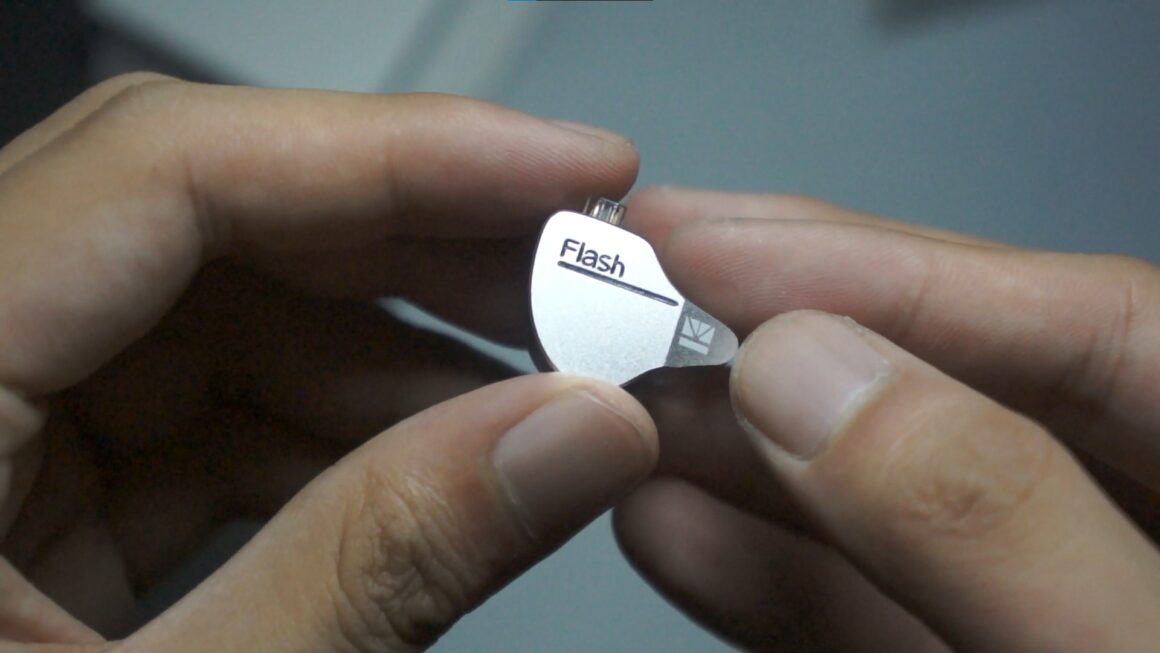
The KBEar Flash is, unfortunately, a ridiculously cheap feeling. Don’t be fooled by it’s metallic exterior as the inner plastic shell has a very thin and cheap feeling material that immediately came out to me the moment I held them in my hands.
The aesthetics are quite clean but tasteful on the Flash. The embossed Flash as well as the printed KBEar logo does add a nice look to the IEM. It’s not winning any beauty contests, but it doesn’t look hideous.
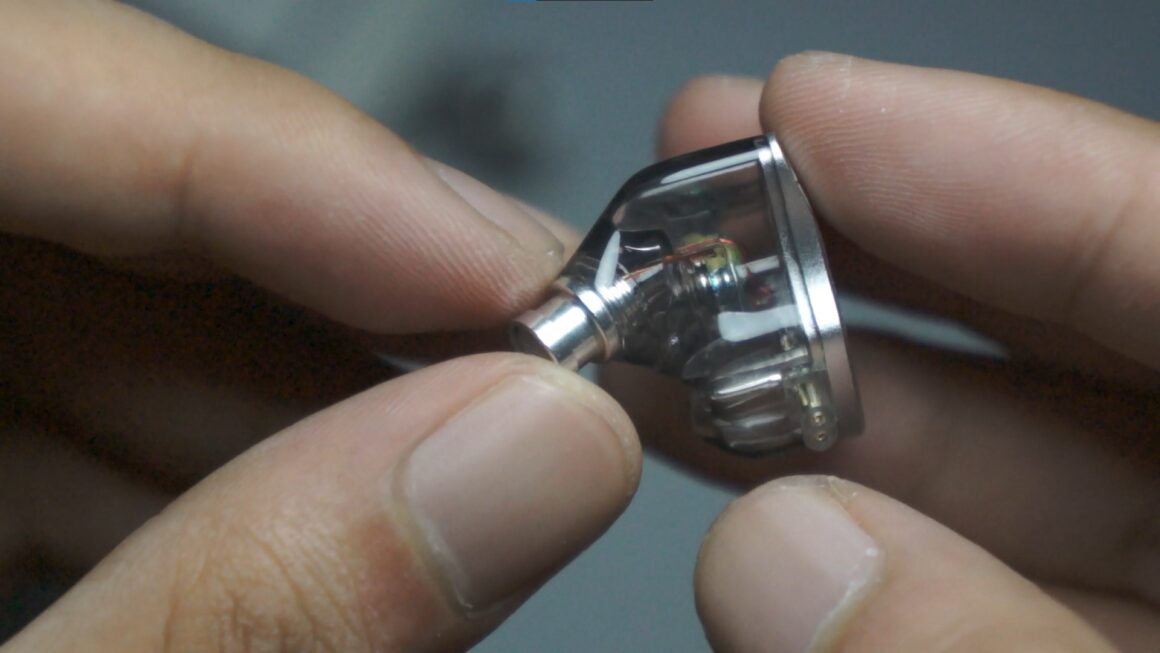
They also sport a QDC connection which is definitely a step down from even the TFZ connector that the Pecker used and will surely throw some people who prefer a sturdier connection. Pair this with the cheap feeling of the IEM and you’ll feel quite paranoid with the longevity of the Flash.
However, the Flash does redeem itself by sporting a very comfortable and well fitting shell that sit very nicely in my ear. It has a somewhat aggressive wing that digs into your ear quite snuggly. This left me wearing the Flash for longer than I thought I would and even brought it into gaming which I will be mentioning soon.
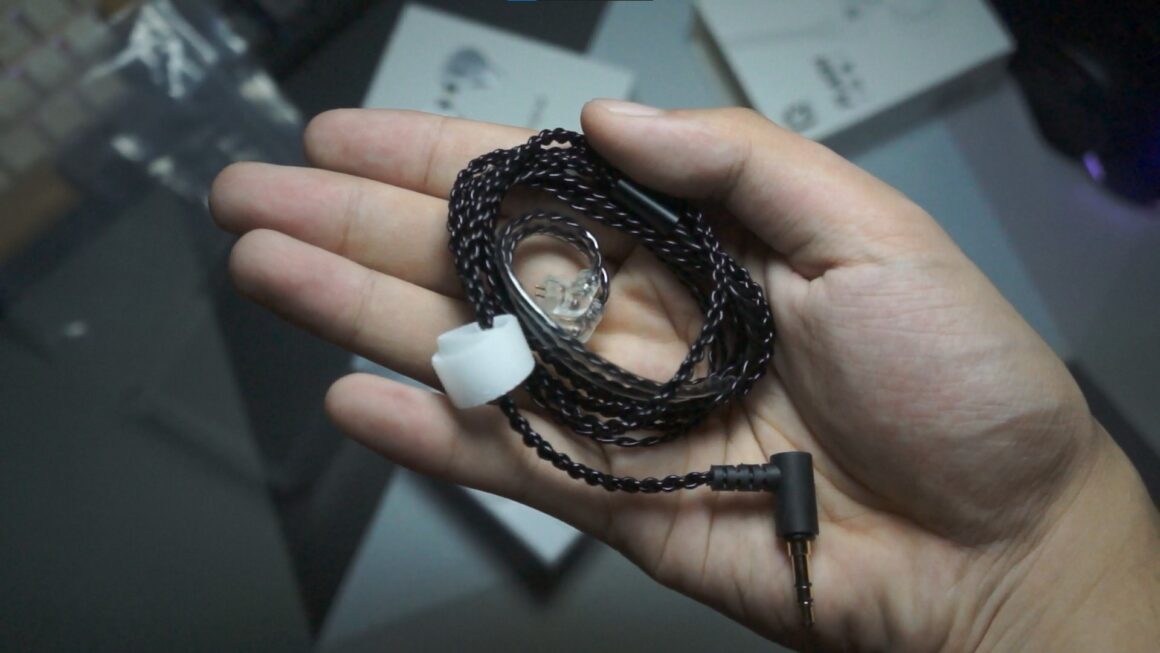
The cable itself is also nothing to write home about and is your basic thin black 4-core cable terminated into 3.5mm. However, I think it is important to mention a rather interesting addition that KBEar offered with the Flash.
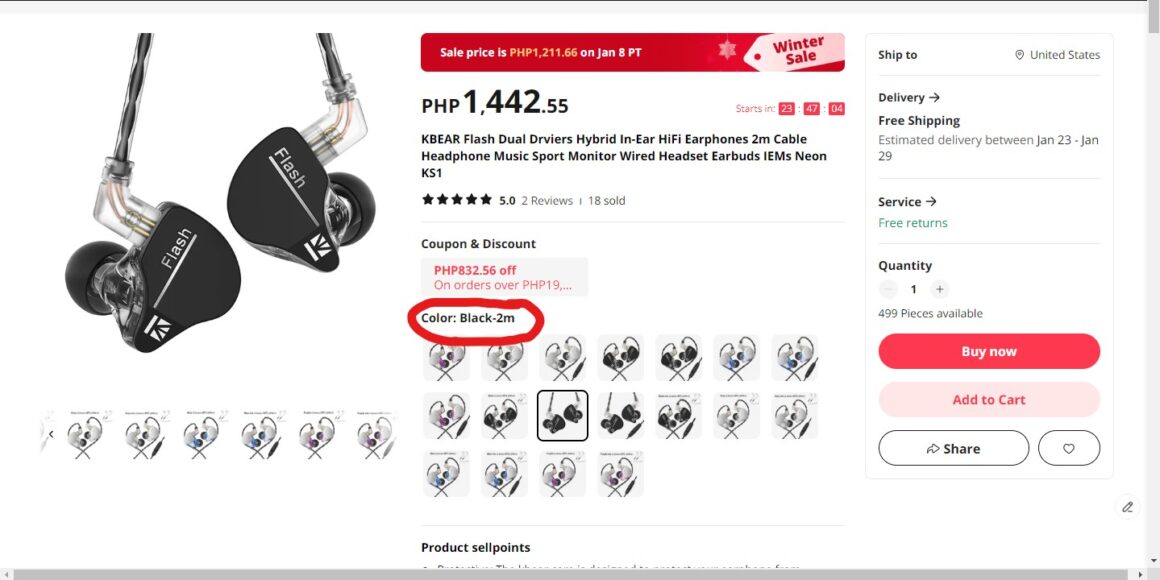
Most IEM cables are only 1.2m long as this is usually the comfortable length for portable use as the cable is neither too long nor too short. The KBEar Flash, on the other hand, offers a 200cm/2m variant for some odd reason. Upon asking the rep, he told me that there was a big demand for 200cm cables domestically on their aftermarket cables which led them to add a 200cm option to their cheapest release.
As someone who likes to use in-ears on my desk, I thought this was a wonderful addition as more often times than not, I’d find myself tugging on the cable as my source is located quite the distance in front of me. This makes 120cm not long enough for comfortable usage, but 200cm allows me to move around more and even tuck the cable where I may not tug it. As far as I know, this is also the first IEM to offer 200cm cables, so props to KBEar for noticing the trends as this will allow for a potentially untapped market to be in KBEar’s hands. All that’s left is improving the quality of the cable itself.
SOUND:
Sound Signature:
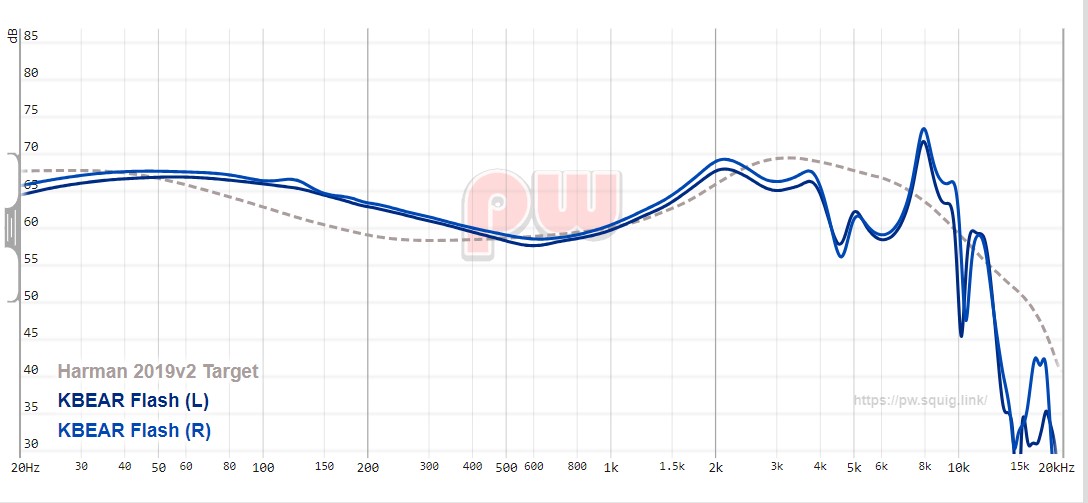
The KBEar Flash has a warm V-Shaped sound signature with extra emphasis on midbass and upper mids.
Drivability:
The KBEar Flash is expectedly easy to drive with an impedance of 32ohms and sensitivity of 108db. Using a smartphone is more than enough to power the Flash at an acceptable level, but at least dongle dac improves midrange coherency and smoothens out the treble while also giving it just a little bit more dynamics.
It has very minimal noise floor even with noisier sources, but there’s still the occasional hiss from very sensitive sources.
As for ideal sources, the Flash prefers a more neutral or brighter leaning source to bring out the details while also taming the bass a tad bit. This doesn’t change the sound signature, mind you. This only improves what the IEM already provides.
Ideal Listening Volume: 50-75%
Bass:
As per KBEar’s usual tuning, the bass is elevated with an almost equal distinction between the subbass and midbass. There’s a lot of body, a lot of kick and punch, and a lot of rumble that bleeds into the midrange.
It really shows its fangs the more volume you throw at it as the bass dynamics pops out and due to the somewhat subdued treble allows for the bass to pop out without added harshness. Lower listening volumes were unfortunately not very impressive as it lost the punchiness that it touted.
Bass heavy tracks are lovely on these as it sounds rich and surprisingly well nuanced. It’s not the tigthest presentation, but it’s able to bring out the intricacies of bass instruments quite well for how it presents bass as a whole.
A track like Hey Barbara by IV of Spades has a prominent bass lick througout the song to which the Flash was able to do justice with enough body to keep each strum real punchy but not so much that it overwhelms the rest of the track. However, it certainly bleeds into the midrange and colors the vocalists.
Mids:
Speaking of the mids, they are definitely recessed in the mix. Male vocals are colored with an extra layer of warmth and some instruments get subdued due to the bass and upper midrange emphasis. However, it does push the instruments far back enough to give a sense of stage width which give it a somewhat more expansive sound. Upper mids are quite forward and potentially shouty, but I never found it to breach my personal tolerance.
A quality that I noticed with the Flash is due to the Warmth and forward upper midrange, it has an almost analogue-like quality that still brings out good nuance in vocals without sounding thin or digital sounding which is common in hybrid sets.
It perfectly compliment tracks with a traditionally more dry sounding mix like Fleetwood Mac’s The Chain or Earth Wind & Fire’s Let’s Groove. The later track having a surprisingly smooth and satisfying listen due to the brighter mix complimenting well the warmer, almost analog-like quality of the midrange.
Treble:
The treble of the Flash is what I can only describe as a dark and smooth yet tinged with a slight brightness in certain regions.
The first thing that really came to me when listening to these for the first time was the somewhat choked and rolled of upper treble region of the Flash. It’s definitely tuned with smoothness in mind, but I’d argue that it overdoes the inoffensiveness and makes the overall tuning too dark.
Regardless, the overall presentation is surprisingly good for being dark. Being a treblehead, I quite enjoyed the smoother and more relaxed presentation that doesn’t totally compromise on detail. Don’t get me wrong, these are far from being a detailed set. But you can hear that BA doing its job of bringing some detail without the cost of sibilance. I was genuinely impressed with the BA implementation of the Flash as their previous set, the Pecker, was riddled with timbre issues with that BA just shouting in your ear. The Flash thankfully has none of that.
Human Bloom’s Capillary keeps the rather snappy and incisive cymbals up top without being pushed far or out from the mix even in the chorus where the bass starts to take over. The vocals in the song also provided good detail without cooking it too much to affect the timbre
Technicalities:
As expected, the technicalities of the Flash are less than stellar due to its focus on musicality rather than technicalities. Not a bad thing mind you, but it does leave certain aspects that left me craving for more.
Separation and layering were one of those things on more complex tracks, there’s definitely some melding of instruments and vocals that distinctly makes the mix a little bit more congested.
As mentioned previously, the stage is quite good. The tuning allows for certain instruments to be pushed back to give the impression of a wider-sounding stage and that bass does a surprisingly good job providing a rather deep-sounding stage.
Imaging is not very stellar when listening to music, but as I’ll mention soon, it does well in other use cases.
REAL WORLD USAGE:
Casual Use:
The Flash are decent for casual use. The fit of the IEM (as long as you tip-roll) is pretty damn good and they’re lightweight which allows for a comfortable wear for longer periods. The cable is definitely a nuisance the longer you spend time with the Flash as it is very tangle prone and makes me worry for its longevity. The L-plug definitely helps with more portable solutions, but the material itself is not my favorite.
Gaming Use:
This is where I found the Flash to really shine. I really enjoyed using the Flash for gaming, particularly Valorant not only due to its comfort but also its tuning allows me to hear footsteps and gunshots more than most of the stuff I’ve tried around this price range.
COMPARISONS:
Vs KBEar Pecker ($35)
The Flash is, in almost every single way, a better Pecker minus the somewhat nerfed build and connector.
They have very similar ergonomics, although as mentioned the Pecker has a more sturdy build with the resin feeling thicker and the TFZ connector, while more obscure, feels more sturdy than QDC.
Where they completely split is in the sound. The Pecker was an absolute mess of an IEM with horrible incoherencies and a very borked tuning.
The Flash, in contrast, is more natural sounding. Despite using the same configuration, the Flash has a more coherent overall sound, cleaner bass and MUCH better midrange timbre as well as a cleaner treble.
Overall, a step in the right direction (even if it may be back from where they were from) for KBEar’s hybrid
Vs KZ Krila ($19)
Another Hybrid that had bad timbre issues, but this time with a more standard, Harman DF style of tuning. It becomes a matter of tastes between the Krila and the Flash with the more treble-centric individuals leaning towards Krila.
Flash is certainly the warmer, smoother option between the two. The upper midrange are pushed up a little earlier than the Krila which will definitely be a make or break for people who prefer a 2k or 3k ear gain. However, the Flash is definitely more tame in the treble region and is overall more coherent.
Details is no contest between the two as the leaner and brighter presentation of Krila brings out more nuance in the mix compared to the Flash.
But again, it becomes a fight of preferences as the Flash offers a more musical listen compared to the more analytical Krila.
CONCLUSION:
KBEar is back! Well, back to where they started with their tradition V-shaped sets. Unlike their recent sets, the Flash strikes a more nostalgic overall sound to KBEar’s tuning with the warmer, more musical tuning while adding the complimentary BA to still give a little bit of detail.
In the Flash’s case, however, the BA doesn’t screech in your ear like their previous releases which is an absolute treat. The DD used in the Pecker was also quite impressive, although definitely needs a little bit of fine tuning to tighten up the overall presentation to avoid the distinct coloration and bleed from the mids.
But overall, the KBEar Flash is a rather hopeful step in the right direction for KBEar as it tackles those who like a warmer, smoother but still decently nuanced tuning. The addition of a 200cm cable also allows KBEar to tackle a niche market as I have not found other brands offering 200cm stock cables.
So what do you have in store for us in 2024? We’ll soon find out. But until then, I can at least be happy to see a Flash of hope for a better year for the brand.
Thank you for checking out my full review of the KBEar Flash. Big thanks KBEar If you would like to buy your own check out the non-affiliated link below: https://www.aliexpress.us/item/3256802957935078.html?gatewayAdapt=glo2usa4itemAdapt
If you have any questions or concerns, contact me on my Facebook page or at obodioreviews@gmail.com
Enjoy music and have a great day!
Last edited:
nxnje
500+ Head-Fier
Pros: - Very easy to drive set with non-fatiguing treble, warm and lush tonality and thick bass;
- Comfort and isolation are great;
- Well built;
- Stock tips are good enough.
- Comfort and isolation are great;
- Well built;
- Stock tips are good enough.
Cons: - Subpar end-to-end extension, a bit unnatural (and, at times, nasal) female vocals due to emphasized upper mids and treble roll-off, average detail retrieval;
- Soundstage is relatively small and resolution could have been better;
- Very tough competition in their price bracket.
- Soundstage is relatively small and resolution could have been better;
- Very tough competition in their price bracket.
Introduction
KBEAR is a well known brand in the Chi-Fi industry thanks to some of their releases that were recognized as very good products.It’s been a while since I've tried anything from KBEAR, and lately they have been in a sort of “stagnation” since other brands were literally running from one release to another while they were a bit passive with few releases that got overlooked for the most.
The KBEAR Flash is their latest release featuring a hybrid configuration (DD+BA) and it’s the one we’re gonna analyze in this review.
Disclaimer: the KBEAR Flash were sent to me from KBEAR free of charge so that I could write an honest review. This review represents my personal opinion on the set and it is by no means a promotional or paid content.
At the time of the review, the KBEAR Flash were on sale for about 30$ at Keephifi’s official Aliexpress store.

Technical Specifications
- Driver Configuration → Hybrid (1 DD + 1 BA)
- Sensitivity → 108 dB
- Impedance → 32 Ω
- Frequency Response Range → 20Hz-20kHz
- Cable → 1,20m 4N silver plated OFC cable with 0.78mm 2-PIN QDC connectors
- Plug Type → L-type gold plated 3,5mm jack connector
Packaging
The packaging is simple and with very few things inside:- The KBEAR Flash
- The cable
- 2 sets consisting in 3 pairs of tips (S, M, L) each set
- User manual


Design and Build Quality
The KBEAR Flash look pretty simple with a resin shell and an opaque and silver-colored faceplate. It’s a good-looking minimal shell design overall so nothing fancy that screams uniqueness.There is a single pressure vent on the ear-facing side of the earpieces, just above the DD, and the nozzle is of average size and sports a small lip.




Cable
The stock cable is nothing to write home about and does the job with no frills. For sure, there’s stuff that comes with a slightly better cable and there’s no doubt about it.Comfort and Isolation
Comfort is very good and I was honestly expecting the Flash to be comfort since KBEAR has always been a benchmark in this regard. Personally, when someone asks me for a very comfortable cheap IEM, the first brand that comes to my mind is KBEAR, and this because their product portfolio is the one with the most comfortable shells around (on average).Isolation is more than decent and definitely enough for outdoor listening sessions.
The stock tips are more than decent and provide a good seal, at least for me.

Sound
GEAR USED FOR THE TEST- DAC: Topping E30
- AMP: Topping L30
- Mobile phones: Samsung Galaxy S7 Edge, Xiaomi Mi A3, Galaxy S23 Ultra
- Dongle: Apple Type-C dongle, Truthear SHIO
- Portable DAPs: Benjie S8/AGPTEK M30B
- Other sources: Presonus AudioBox iONE, ElGato Wave XLR, KZ AZ10, Moondrop May's DSP Cable with PEQ=0
Do they need an amplifier?
The KBEAR Flash don’t need an amplifier, and they don’t improve a lot when connected to a proper amplifier.
Sound signature
The KBEAR Flash is a very warm and mild V-shaped set with some upper midrange emphasis.
Lows
Sub-bass is present but not prominent, with an elevated and thick bass that adds some fun to the mix.The texture isn't bad for the price, but this low-end it’s more about the fun factor and thickness rather than speed and texture quality.
I don’t think it’s a truly basshead IEM, but I am sure those who love bass and warm sets will find a satisfying low-end in the KBEAR Flash.
Mids
The midrange is slightly recessed as expected on a U-Shaped set. The lower mids are forward with a thick timbre that makes male vocals and acoustic instruments very warm. The upper midrange is also slightly emphasized with female vocals sounding very intimate but not as energetic and clear as they should be. In fact, due to the lack of treble extension, vocals sometimes sound unnatural and nasal, while violins, cellos and electric guitars lack the sparkle and energy that they usually need. Those who don’t like upper-midrange “borderline” stuff with a very rolled-off treble may not like the overall tuning.
Highs
The highs are non-fatiguing with a very noticeable upper treble roll-off and detail retrieval is nothing to write home about.
It’s a pretty intimate-sounding and in-your-head IEM with mediocre treble extension, but it’s also safe to say that these are basically fatigue-free and very good for treble sensitive people or night listening sessions.
Soundstage is perceived as small-sized while imaging is decent considering the very warm and thick nature of the signature.
KBEAR Flash vs Truthear Hola
Both are warm, both are non fatiguing, both go for a U-shaped signature, but even though they may seem to share a lot, they sound pretty different.The Hola are a bit more sub-bassy whereas the Flash are bassier. The lower midrange is thicker on the Flash with warmer and deeper male vocals and instruments like acoustic and classic guitars or piano. The upper midrange is slightly leaner on the Truthear Hola, that perform generally better and less fatiguing when it comes to vocals, even though male vocals are slightly less warm and deep than on the Flash. The highs are non-fatiguing on both but the Hola sound a touch less closed-in and more detailed than the Flash.
Soundstage and imaging are slightly better on the Hola even though the Flash have a pretty good imaging considering the very warm and thick nature of their sound signature.
The build quality is good on both. The Hola are shipped with a softer and more comfortable cable.
Comfort is very similar (great on both) even though the Hola are a bit trickier to wear because of their shorter nozzles (which creates the need for some tip rolling), whereas isolation is marginally better on the KBEAR Flash.
KBEAR Flash vs TRN MT4 Pro
These are pretty different. Both are U-shaped but while the MT4 Pro Harman-ish, the KBEAR Flash are thicker, warmer, with less pinna gain, less sub-bass and less-treble.Sub-bass and bass are more impactful on the MT4 Pro, that have a better low-end hands down. The lower mids are better on KBEAR Flash, with better male vocals, acoustic and classic instruments, while the MT4 Pro have more energy and sparkle when it comes to violins, female vocals, sax and so on, with a slightly more natural timbre. One thing to note, though, is that the MT4 Pro sometimes get sibilant, thing that doesn’t happen on the KBEAR Flash. The highs have more details and sparkle on the MT4 Pro, that also have better upper treble extension. The KBEAR Flash, on the other hand, are much less fatiguing with a softer, warmer and overall darker treble that favors long listening sessions.
Soundstage is better on the MT4 Pro, while imaging is on par more or less.
Build quality is better on the KBEAR Flash. The stock cable isn’t dramatically different but the one included with the MT4 Pro looks and feels a tad better.
Comfort and isolation are better on the KBEAR Flash.
KBEAR Flash vs Celest Wyvern Pro
These two IEMs share the same price bracket more or less but sound very different.The KBEAR Flash have a thicker and more prominent low-end with more quantity than quality, while the Wyvern Pro have a faster, more textured yet less thick bass, with a slightly better sub-bass extension. The lower midrange is more emphasized on the KBEAR Flash, whereas the upper midrange is more present, energetic and clearer on the Wyvern Pro, even though the latter can easily become borderline shouty on some tracks. The treble is darker, more polite and less detailed on the KBEAR Flash, while the Wyvern Pro have more details and more sparkle overall, even though their upper treble extension isn’t anything special.
Soundstage and imaging are way better on the Wyvern Pro.
Build quality is great on both, the Wyvern Pro come with a better cable overall.
Comfort is better on the KBEAR Flash since the Wyvern Pro have a protruding shell wing that may not appeal to some people, and isolation is on par more or less.
Final Thoughts
After the great KBEAR Ink MKII and the disappointing Streamer and Pecker, which registered many bad reviews around the web, KBEAR has released the Flash, a set that goes all-in on the warm and lush timbre with a thick bass, very warm male vocals, a noticeably rolled-off (and almost dark) treble, and all of this while being very easy to drive and very comfortable to wear. Despite these strengths, though, the timbre and tonality are unnatural for the most, the sub-bass lacks proper extension when compared to the forward midbass and female vocals miss their natural clarity and energy due to the lackluster treble extension.The KBEAR Flash is a very warm and pleasing IEM, but going safe is not enough to compete in the very crowded market we’re living nowadays, especially when many competitors boast better resolution, staging capabilities, detail retrieval and an overall better sound experience. The flash is only “average” technically, and even though I find some uniqueness and effort in their timbrical approach and in the overall cohesiveness between the drivers, I think that they’re not up to par with the competition.
They will be loved by some (for sure), but I think an extra effort could have been done since they compete in a very difficult market.
I know what KBEAR is capable of and I don't think the Flash deserve to represent their potential. I am sure that KBEAR has much more for us and I cannot wait to try the stuff they’ll be releasing this year.
Attachments
L
LikeHolborn
ima call it hp
nxnje
Why "hp"? 
L
LikeHolborn
i think i heard someone mention as much you raise the volume you gain in bass... well cars have hp and torque, hp comes on at high rpm while tq is known at low 



